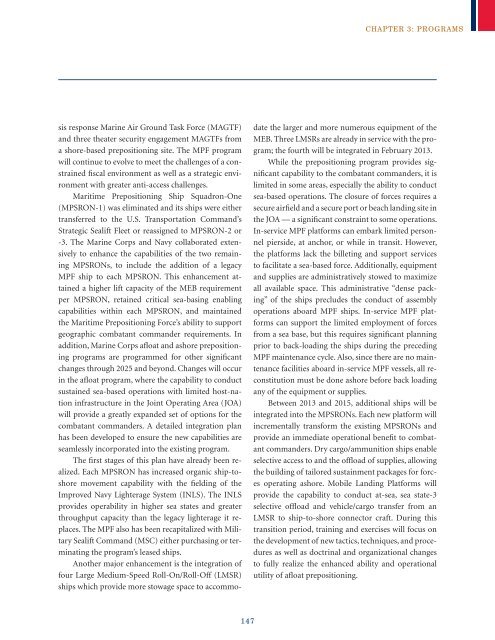USMC Concepts & Programs 2013 - Defense Innovation Marketplace
USMC Concepts & Programs 2013 - Defense Innovation Marketplace
USMC Concepts & Programs 2013 - Defense Innovation Marketplace
Create successful ePaper yourself
Turn your PDF publications into a flip-book with our unique Google optimized e-Paper software.
chapter 3: programs<br />
sis response Marine Air Ground Task Force (MAGTF)<br />
and three theater security engagement MAGTFs from<br />
a shore-based prepositioning site. The MPF program<br />
will continue to evolve to meet the challenges of a constrained<br />
fiscal environment as well as a strategic environment<br />
with greater anti-access challenges.<br />
Maritime Prepositioning Ship Squadron-One<br />
(MPSRON-1) was eliminated and its ships were either<br />
transferred to the U.S. Transportation Command’s<br />
Strategic Sealift Fleet or reassigned to MPSRON-2 or<br />
-3. The Marine Corps and Navy collaborated extensively<br />
to enhance the capabilities of the two remaining<br />
MPSRONs, to include the addition of a legacy<br />
MPF ship to each MPSRON. This enhancement attained<br />
a higher lift capacity of the MEB requirement<br />
per MPSRON, retained critical sea-basing enabling<br />
capabilities within each MPSRON, and maintained<br />
the Maritime Prepositioning Force’s ability to support<br />
geographic combatant commander requirements. In<br />
addition, Marine Corps afloat and ashore prepositioning<br />
programs are programmed for other significant<br />
changes through 2025 and beyond. Changes will occur<br />
in the afloat program, where the capability to conduct<br />
sustained sea-based operations with limited host-nation<br />
infrastructure in the Joint Operating Area (JOA)<br />
will provide a greatly expanded set of options for the<br />
combatant commanders. A detailed integration plan<br />
has been developed to ensure the new capabilities are<br />
seamlessly incorporated into the existing program.<br />
The first stages of this plan have already been realized.<br />
Each MPSRON has increased organic ship-toshore<br />
movement capability with the fielding of the<br />
Improved Navy Lighterage System (INLS). The INLS<br />
provides operability in higher sea states and greater<br />
throughput capacity than the legacy lighterage it replaces.<br />
The MPF also has been recapitalized with Military<br />
Sealift Command (MSC) either purchasing or terminating<br />
the program’s leased ships.<br />
Another major enhancement is the integration of<br />
four Large Medium-Speed Roll-On/Roll-Off (LMSR)<br />
ships which provide more stowage space to accommodate<br />
the larger and more numerous equipment of the<br />
MEB. Three LMSRs are already in service with the program;<br />
the fourth will be integrated in February <strong>2013</strong>.<br />
While the prepositioning program provides significant<br />
capability to the combatant commanders, it is<br />
limited in some areas, especially the ability to conduct<br />
sea-based operations. The closure of forces requires a<br />
secure airfield and a secure port or beach landing site in<br />
the JOA — a significant constraint to some operations.<br />
In-service MPF platforms can embark limited personnel<br />
pierside, at anchor, or while in transit. However,<br />
the platforms lack the billeting and support services<br />
to facilitate a sea-based force. Additionally, equipment<br />
and supplies are administratively stowed to maximize<br />
all available space. This administrative “dense packing”<br />
of the ships precludes the conduct of assembly<br />
operations aboard MPF ships. In-service MPF platforms<br />
can support the limited employment of forces<br />
from a sea base, but this requires significant planning<br />
prior to back-loading the ships during the preceding<br />
MPF maintenance cycle. Also, since there are no maintenance<br />
facilities aboard in-service MPF vessels, all reconstitution<br />
must be done ashore before back loading<br />
any of the equipment or supplies.<br />
Between <strong>2013</strong> and 2015, additional ships will be<br />
integrated into the MPSRONs. Each new platform will<br />
incrementally transform the existing MPSRONs and<br />
provide an immediate operational benefit to combatant<br />
commanders. Dry cargo/ammunition ships enable<br />
selective access to and the offload of supplies, allowing<br />
the building of tailored sustainment packages for forces<br />
operating ashore. Mobile Landing Platforms will<br />
provide the capability to conduct at-sea, sea state-3<br />
selective offload and vehicle/cargo transfer from an<br />
LMSR to ship-to-shore connector craft. During this<br />
transition period, training and exercises will focus on<br />
the development of new tactics, techniques, and procedures<br />
as well as doctrinal and organizational changes<br />
to fully realize the enhanced ability and operational<br />
utility of afloat prepositioning.<br />
147

















